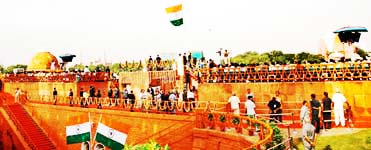Flag Hoisting
 “Under this flag, there is no difference between a prince and a peasant, between the rich and the poor, between man and women."
“Under this flag, there is no difference between a prince and a peasant, between the rich and the poor, between man and women."
-- Mrs. Sarojini Naidu
Preamble of the Flag Code of India says that: "The significance of the colours and the chakra in the National Flag was amply described by Dr. S. Radhakrishnan in the Constituent Assembly which unanimously adopted the National Flag. Dr. S. Radhakrishnan explained -
"Bhagwa or the saffron colour denotes renunciation of disinterestedness. Our leaders must be indifferent to material gains and dedicate themselves to their work."
"The white in the centre is light, the path of truth to guide our conduct."
"The green shows our relation to soil, our relation to the plant life here on which all other life depends." Continue...
"The Ashoka Wheel in the centre of the white is the wheel of the law of dharma. Truth or satya, dharma or virtue ought to be the controlling principles of those who work under this flag. Again, the wheel denotes motion. There is death in stagnation. There is life in movement. India should no more resist change, it must move and go forward. The wheel represents the dynamism of a peaceful change."
On 15 August 1947 India and Pakistan were created. India adopted the tricolour of orange, white, and green with a blue Ashoka Chakra at the centre. Unofficially this tricolour had been the flag of the Indian National Congress. The orange colour represented Hinduism, the green colour - Islam and the white colour represented peace. There was a blue spinning wheel in the centre, which represented Gandhiji's call for economic self-sufficiency through hand spinning.
Prime Minister of India hoists the flag and pays his homage to the freedom fighters and addresses the Nation. Children are brimming with enthusiasm on this day. Early in the morning, they attend the flag hoisting ceremony in their schools. They sing patriotic songs and present skits and dramas based on the freedom struggle.
...Back
